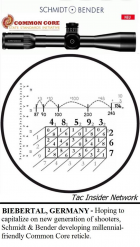moondog
Gold $$ Contributor
Most my moa ffp scopes have at least 25 moa per rev. Schmidt, N.F. Razor2.Question 1: Buy MIL or MOA now?
Well, that really depends on the game and also somewhat of FFP vs SFP.
A lot of SFP scopes are MOA scope sand these are better suited for precision games like F-class and Benchrest in KD ranges. The apparent size of the reticle gets smaller with magnification and you don't need the ranging capabilities of an FFP scope There are MIL reticles in SFP scopes, but the MOA is more prevalent and better suited for NRA competitions.
The FFP scopes "usually" come with MIL reticles/knobs, and it's easier to range distance with an FFP scope. The apparent reticle size will remain the same on target as magnification grows, but in the eyepiece, it will grow and that can be disconcerting for SFP users.
I have shot a lot of F-Class and everything in that game is MOA. When people come to play and bring a MIL scope, it confuses this old man, but I can power through it if I have to. I strongly recommend an SFP/MOA combo for that.
I have shot a tiny bit of PRS and I can see where an SFP/MOA scope is not indicated. In the most recent PRS match I shot, the target distances were provided ahead of time, but they were from 300 yards to 1000 yards, and at various distances. I worked up a list of the target distances and the MIL offset from a 100 yard zero. Everything but the 1000 yard target was available within one rotation.
Let's say I had 3 distances to deal with on a stage: 317 yards, 548 yards and 784 yards. I had worked out the come ups prior to the match for the listed distances, all values were from 100 yard zero. For example, the values for those 3 distances would be something like 4.7 @ 317, 6.1 @ 548, and 8.4 @ 784. My scope has 10MIL/rotation, with 0.0 set for 100 yards. For each stage, I would have the dial set at the first distance for that stage, then I would dial to the distance of the next shot and so on. The number would be exact on the dial and provided you had properly calculated the come-ups, you could blindly dial for the next distance, hold on and compensate for the wind and take the shot. If you saw the splash near the target, your Christmas tree reticle would help you figure out your correction.
That would be a little more complicated with MOA as these division as 1/4 or 1/8 and there's 3.5 times more MAOs than MILs for the same distance. You would have something like 14 & 3/4 @ 317, 21 & 1/4 @ 548 and 29 & 2/4 @784. That's more complicated dialing, especially if your knob is 10MOA/rotation.
So, depends on the game.
Question 2: LPVOs. That has changed a great deal in the last few years. The top of the line right now is the March-F 1-10X24 with dual reticle in MIL. I think MOA is too fine for LPVOs.
Not a valid comparison. I think it's more the convenience of being able to TALK with others in one language











